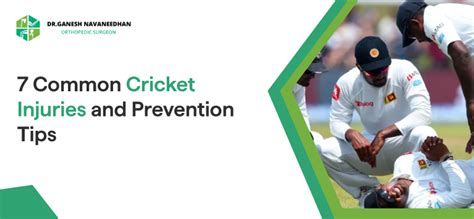Explore injury prevention in cricket with effective warm-up routines, proper technique, strength training, and nutrition tips for cricketers. Stay safe on the field!Injury Prevention Tips For Cricketers
In the fast-paced world of cricket, athletes often push their bodies to the limits, making injury prevention crucial for maintaining performance and longevity in the sport. Whether you are a seasoned player or just starting out, understanding the common injuries associated with cricket is the first step towards safeguarding your health. This article delves into essential injury prevention strategies tailored specifically for cricketers, including effective warm-up routines, the importance of proper technique, strength training exercises, and the critical role of nutrition and hydration. By equipping yourself with these insights, you can enhance your game while minimizing the risk of injury. Join us as we explore practical tips and effective approaches to keep you on the field and at your best throughout the season.
Understanding Common Injuries In Cricket: The First Step To Injury Prevention
Cricket, known for its thrilling gameplay, often puts players at risk of various injuries. Recognizing these common injuries is crucial for effective injury prevention strategies. Here, we explore the typical injuries cricketers face and how understanding them is vital for maintaining player health and performance.
Some of the most prevalent injuries among cricketers include:
- Hamstring Strains: These occur due to sudden sprints or overstretching during play, often impacting fast bowlers and players in the field.
- Rotator Cuff Injuries: Common among bowlers, these injuries affect the shoulder’s stability and mobility, resulting from repetitive throwing or bowling motions.
- Wrist and Finger Injuries: Fielders are particularly susceptible to these injuries from catching or throwing the ball incorrectly.
- Lower Back Pain: Often caused by improper bowling techniques or inadequate core strength, this can hinder a player’s overall performance.
- Knee Injuries: These can arise from sudden changes in direction, particularly while running between the wickets or fielding.
Understanding these injuries not only aids in the implementation of preventive measures but also ensures that players can recover more effectively if they do occur. Incorporating proper training routines, utilizing appropriate techniques, and maintaining good physical conditioning are all critical steps towards achieving effective injury prevention in cricket.
Effective Warm-Up Routines For Injury Prevention In Cricketers
A proper warm-up routine is crucial for injury prevention in cricketers. Engaging in a well-structured warm-up can improve performance and significantly reduce the risk of injuries. Here are some effective warm-up strategies:
- Dynamic Stretching: Focus on dynamic stretches that promote flexibility and enhance blood flow to your muscles. Leg swings, arm circles, and torso twists are excellent exercises to include in your routine.
- Sport-Specific Drills: Incorporate drills that mimic movements specific to cricket, such as running, batting swings, and bowling actions. This prepares your body for the demands of the game.
- Agility Exercises: Activities that improve agility, such as ladder drills or cone sprints, can help enhance your coordination and balance, which are vital for on-field performance.
- Gradual Intensity Increase: Start with low-intensity movements and gradually increase intensity. This helps in preparing your muscles and joints for the more strenuous activities that follow in a match or training session.
- Cool Down: While not part of the warm-up, a proper cool-down after practice or games is equally important for injury prevention. Include static stretching and low-intensity activities to help your body recover and reduce muscle soreness.
By implementing these warm-up routines, cricketers can lay the foundation for effective injury prevention, ensuring they remain fit and ready to perform at their best throughout the season.
Importance Of Proper Technique For Injury Prevention In Cricket
One of the foundational pillars of injury prevention in cricket is the mastery of proper technique. Whether batting, bowling, or fielding, a sound technique not only enhances player performance but also greatly reduces the risk of injuries. Let’s delve deeper into why proper technique is crucial for cricketers.
When players utilize correct form, it ensures that their bodies are aligned appropriately, mitigating undue stress on muscles and joints. Below are key reasons why mastering technique is essential for injury prevention:
| Technique Aspect | Impact on Injury Prevention |
|---|---|
| Bowling Action | Proper bowling action reduces strain on the shoulder and elbow joints, lowering the risk of overuse injuries. |
| Batting Stance | A balanced stance allows for better weight distribution, improving swing mechanics and reducing lower back strain. |
| Fielding Position | Correct fielding techniques help prevent sudden movements that can lead to muscle pulls or ligament tears. |
| Running Techniques | Using proper running form decreases the likelihood of knee and ankle injuries caused by missteps. |
Additionally, players should regularly work with coaches to refine their techniques, receive feedback, and participate in drills that reinforce safe practices. Incorporating video analysis can also significantly aid in identifying and correcting flaws in technique.
A commitment to mastering proper technique is indispensable for cricketers seeking effective injury prevention. By prioritizing sound mechanics, players can enhance their longevity and performance in the sport.
Strength Training Exercises That Enhance Injury Prevention
In the world of cricket, the physical demands on players are immense, making injury prevention a top priority. One of the most effective ways to reduce the risk of injuries is through a well-structured strength training program. Here are some key exercises that can help enhance injury prevention for cricketers:
| Exercise | Muscle Groups Targeted | Benefits for Injury Prevention |
|---|---|---|
| Squats | Quadriceps, Hamstrings, Glutes | Strengthens lower body and improves stability, reducing the risk of knee injuries. |
| Planks | Core muscles | Enhances core stability, which is crucial for maintaining balance during play and preventing back injuries. |
| Deadlifts | Hamstrings, Glutes, Lower back | Strengthens the entire posterior chain, improving posture and decreasing lower back strain. |
| Lunges | Quadriceps, Hamstrings, Glutes | Improves unilateral leg strength and balance, which is vital for quick lateral movements in cricket. |
| Shoulder Press | Shoulders, Triceps | Strengthens shoulder joints, which is essential for bowlers and batters to prevent rotator cuff injuries. |
Incorporating these strength training exercises into a regular fitness routine can significantly enhance injury prevention efforts for cricketers. It’s essential to aim for proper form and gradually increase weights to ensure the body adapts appropriately while minimizing injury risks.
Nutrition And Hydration: Key Factors In Injury Prevention For Cricketers
Nutrition and hydration play a pivotal role in injury prevention for cricketers. Proper dietary practices not only enhance performance but also significantly reduce the risk of injuries. Here are some essential elements to consider:
1. Balanced Diet
A well-rounded diet is crucial for maintaining overall health. Cricketers should focus on a mix of carbohydrates, proteins, fats, vitamins, and minerals. Carbohydrates provide energy, proteins aid in muscle repair, and fats support overall bodily functions.
2. Hydration
Staying hydrated is vital, especially during prolonged matches and training sessions. Dehydration can lead to decreased performance and increases the likelihood of cramps and strains. Aim to drink water regularly and consider using electrolyte drinks during intense activity or in hot conditions.
3. Timing of Meals
Eating at the right times can influence a player’s energy levels and recovery. Consuming a carbohydrate-rich meal about three hours before a match can provide the necessary energy. Additionally, post-match meals rich in protein can help with muscle recovery.
4. Supplements
While a balanced diet should meet most nutritional needs, some players might benefit from supplements. Omega-3 fatty acids, for instance, can help reduce inflammation, and multivitamins can help ensure adequate nutrient intake. Always consult with a nutritionist or health professional before starting any supplements.
5. Individual Needs
Each cricketer’s nutritional needs might differ based on factors such as age, weight, position, and activity level. Personalizing a nutrition plan helps optimize performance and contributes to long-term injury prevention.
A solid focus on nutrition and hydration not only enhances a cricketer’s performance but is also a cornerstone of effective injury prevention. By prioritizing these elements, players can maintain their physical health and prolong their careers on the field.
Frequently Asked Questions
What are some common injuries faced by cricketers?
Cricketers often face injuries such as sprains, strains, fractures, and muscle tears, particularly in the shoulders, knees, and lower back.
How important is warm-up before playing cricket?
Warm-up is essential as it prepares the body for physical activity, increases blood flow to the muscles, and reduces the risk of injuries.
What role does hydration play in injury prevention for cricketers?
Proper hydration helps maintain physical performance, supports muscle function, and reduces the risk of cramping and heat-related illnesses.
Are there specific exercises to prevent injuries in cricket?
Yes, exercises focusing on strength, flexibility, and core stability can significantly reduce the risk of injuries among cricketers.
How does using the right equipment prevent injuries?
Using appropriate and well-fitted gear, such as pads, helmets, and supportive footwear, can help protect players from injury during games.
What recovery strategies can cricketers use to avoid injuries?
Recovery strategies like rest, ice therapy, and physiotherapy can help alleviate soreness and prevent further injuries after physical activity.
Is it important to consult a coach or trainer for injury prevention?
Yes, consulting a coach or trainer can provide valuable insight into proper techniques and personalized training programs that help in preventing injuries.









